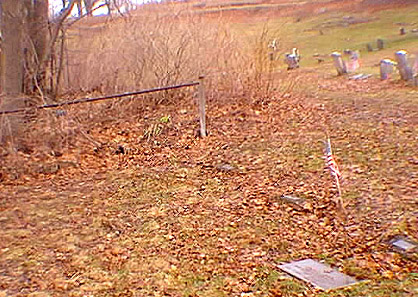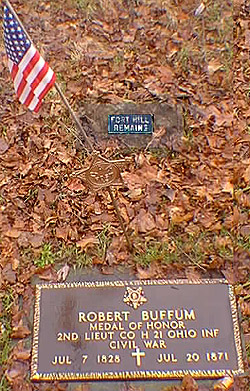 NYCHS photos: (Above) Auburn inmates' burial plots in foreground near Soule Cemetery in background. (At right) Robert Buffum plaque near "Fort Hill Remains" marker. Flag is placed there annually. Medal of Honor Rite at Auburn Inmate Grave |  |
 NYCHS photos: (Above) Auburn inmates' burial plots in foreground near Soule Cemetery in background. (At right) Robert Buffum plaque near "Fort Hill Remains" marker. Flag is placed there annually. Medal of Honor Rite at Auburn Inmate Grave |  |
Little information is available about the patients that died while in the State Asylum for Insane Criminals at Auburn. Fortunately the unusual circumstances of the violent suicide of one man were recorded in a local
newspaper. The record was retrieved 123 years later to verify
his identity and his final resting place.
The Civil War exploits of Robert Buffum -- who slashed his throat in a cell in the Asylum -- were not recognized when his unclaimed corpse was placed in prison ground on July 21, 1872. His heroism as a Union soldier was unknown to Asylum staff. As a Yankee soldier Buffum had been a member of Andrews Raiders, a group of 22 spies who sneaked into Confederate territory in 1862. They captured a locomotive and attempted to burn railroad bridges to isolate train service to Chattanooga, Tenn. While their mission was only partially successful, they did disrupt communications and delay Confederate troop movements. . . .
Lt. Buffum was awarded the Medal of Honor for gallantry displayed in action against the enemy.The Medal of Honor is the oldest and highest decoration awarded by the United States Government. It was created . . . to show appreciation for unusual bravery and heroism. The medal was presented to Buffum and five others by President Abraham Lincoln himself. Buffum was the third person to receive the Medal of Honor in the entire country. Unfortunately Buffum became an uncontrollable alcoholic in the post war period. He also suffered psychological damage as a result of the war and of the time spent as a prisoner in the hands of the Confederates. Buffum spent three years in a mental hospital after he left the Army. A short time after his release from the hospital he began to drink again and, one night following an argument with a man who vilified President Lincoln, he shot and killed the man.
He was indicted for murder and sent to the State Asylum at Auburn as an insane criminal. Despondency may have been the cause of his suicide behind the barricade he put in front of his cell door fo stop anyone from entering the cell. In 1994, after a period of lengthy research, the Medal of Honor Society tracked down the whereabouts of the remains of Robert Buffum.
During the period between his burial in the State Lot [at Fort Hill Cemetery] and the discovery of his final resting place, Buffum's corpse had been moved to a new state burial ground three and a half miles away [in an area adjacent to Soule Cemetery in the Town of Sennett] where it rested in an unmarked grave, really a mass grave containing many convict corpses. The Medal of Honor Society is dedicated to preserving the memory of deceased recipients of the Medal of Honor. Regardless of what Buffum may have done after the war, he was a hero who had risked his life during wartime. The society wanted to place a special marker over his gravesite. On July 29, 1995, members of the Medal of Honor historical society honored the resting place of Lt. Robert Buffum with a marker testifying to his bravery during the Civil War. Many Buffum family members attended the brief but impressive ceremony. Officials from Auburn Correctional Facility also participated in recognizing the veteran. Volunteers have maintained the gravesite ever since. Each year a new American flag is placed on the grave, in memorium. Webmaster Note -- For additional information and for larger and more images, visit the source sites of the non-NYCHS images above:
To Auburn&Osborne menu page. |